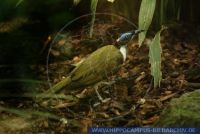Entomyzon cyanotis
Blue-faced Honeyeater
Exif Keywords:
Exif ImageDescription:
The Blue-faced Honeyeater (Entomyzon cyanotis), also colloquially known as Bananabird, is a passerine bird of the Honeyeater family Meliphagidae commonly found around the northern and eastern coasts of Australia and New Guinea. Three races are recognised. It is large for a honeyeater and easily identified by its bare blue face-patch. Its diet is made up of nectar and invertebrates....A large honeyeater 25-32 cm (9-13 inches) in length, the adult Blue-faced honeyeater is easily recognised by its patch of bare blue skin around its eyes. The head and throat are otherwise predominantly blackish with a white stripe around the nape and another from the cheek. The underparts are white and the back and wings olive in colour. Juveniles are distinguished by their yellow or greenish face patches and dark brown rather than black on the head. The call is a ki-owt.They live throughout open woodland, pandanus, paperbarks, mangroves, watercourses, parks and gardens. They are commonly known to suck the nectar out of grevillea trees and are very common around the backyard.Their diet consists of pollen, berries, nectar, and cultivated crops such as bananas or particularly grapes, but the bulk of their diet consists of insects. Usually very inquisitive, and friendly birds, they will often invade a campsite, searching for edible items.Blue-faced honeyeaters may nest from June to January, breding once or twice during this time. The nest is an untidy deep bowl of sticks and bits of bark in the fork of a tree, Birds Nest or Staghorn Fern or deserted babbler nest. Two or rarely three eggs are laid, 22 x 32 mm and buff-pink splotched with red-brown or purplish colours. It is one of the many bird species parasitised by the Asian Koel.Source:Wikipedia
Viewed 5966 times





